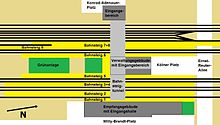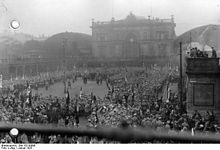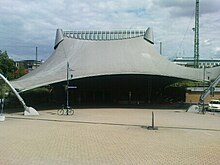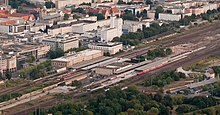Magdeburg main station
| Magdeburg Central Station | |
|---|---|
|
Reception building of Magdeburg Central Station
|
|
| Data | |
| Design | Island station |
| Platform tracks | 9 |
| abbreviation | LM |
| IBNR | 8010224 |
| Price range | 2 |
| opening | May 15, 1873 |
| Profile on Bahnhof.de | Magdeburg_Hbf |
| Architectural data | |
| Architectural style | Tuscan palazzo |
| architect |
Ludwig Heim (architect) Otto Peters (site manager) |
| location | |
| City / municipality | Magdeburg |
| Place / district | Old Town (Magdeburg) |
| country | Saxony-Anhalt |
| Country | Germany |
| Coordinates | 52 ° 7 '50 " N , 11 ° 37' 40" E |
| Railway lines | |
|
|
| Railway stations in Saxony-Anhalt | |
The Magdeburg Central Station is in the center of the state capital Magdeburg in Saxony-Anhalt located. It belongs to station category 2.
investment
The main station is a through station , but also an island station, as part of the station building is between tracks 5 and 6. The train station tracks are covered and can be reached by stairs or elevators. The reception hall opens into an underground station tunnel that leads to the platforms. There are around 20 shops and restaurants throughout the station, including McDonald’s and Subway .
The main station building is accessible in the north through the side entrance on Kölner Platz , in the west through the side entrance on Konrad-Adenauer-Platz and in the east through the main entrance on Willy-Brandt-Platz . There are currently taxi ranks at Konrad-Adenauer-Platz and Willy-Brandt-Platz. After the construction of a tunnel for private traffic on Damaschkeplatz, the taxi ranks are to be concentrated in the west in the coming years. There are parking spaces at the station in all three forecourt. You can also park in the parking garage of the City Carré Magdeburg shopping center, which is located directly at the main train station .
history
precursor
In the place of the current main station there were originally facilities of the Magdeburg Fortress . The railway lines to other cities, initially built by various railway companies between 1839 and 1849, each had their own train stations. They were located near the Elbe on the western bank of the river, which was artificially raised for this purpose. Remnants of the Magdeburg railway gates still bear witness to this past on the banks of the Elbe. With increasing industrialization and the growing importance of Magdeburg, the space requirements for train stations grew. However, a central train station could not be implemented at this point.
prehistory
The already existing railway systems of the city of Magdeburg were no longer able to cope with the rapidly growing transport tasks, the construction of a new central station became urgent, but there was no site available in the city. Both the city of Magdeburg and various railway companies had protracted negotiations with the military authorities in order to buy the no longer required fortress site, initially together, and finally in parallel. In 1870 the three railway companies Berlin-Potsdam-Magdeburg Railway Company , Magdeburg-Halberstädter Railway Company , Magdeburg-Köthen-Halle-Leipzig Railway Company were able to acquire 33 hectares of the fortress site in the west.
Construction from 1870
In 1870 the foundation stone for the new central train station in Magdeburg was laid. The Berlin-Potsdam-Magdeburg Railway Company and the Magdeburg-Halberstädter Railway Company were involved, both of which suffered greatly from the limited space available in the railway systems on the banks of the Elbe. The Magdeburg-Köthen-Halle-Leipziger Eisenbahngesellschaft, on the other hand, did not show any great interest in the new building, as it had hardly any problems with the existing situation.
Each of the two railway companies wanted to have their own representative station building. The Magdeburg-Köthen-Halle-Leipziger Eisenbahngesellschaft built the eastern station building in the style of a Tuscan palazzo between 1872 and 1882 . The outer cladding was made of sandstone that was extracted in Ostlutter near Lutter am Barenberge in what is now the district of Goslar. The western station building was built by the Berlin-Potsdam-Magdeburg railway company and was also used by the Magdeburg-Halberstädter railway company. In contrast to the eastern building, Nebra sandstone was used for the north facade : the wall surfaces, on the other hand, consisted of brick facing stones. Both buildings were of the same length and were connected by a passenger and luggage tunnel. The platforms were each spanned with halls.
On May 15, 1873, the first train ran between the new central station and the city of Burg . The official handover for traffic took place on August 18, 1873. The construction work was not fully completed until around 1893.
In addition to the railway systems for travel, extensive freight transport systems were also built. The associated freight transport facilities were built southeast of the reception building of the Magdeburg-Köthen-Halle-Leipzig railway company. The Berlin-Potsdam-Magdeburg railway company, on the other hand, had its facilities west of its own reception building. Of course, treatment systems were also required for the locomotives and wagons of the respective railway company. Two large round locomotive sheds were built to the south (between the routes to Magdeburg-Sudenburg and Magdeburg-Buckau ) for the locomotives . Only the social building is left of these facilities. This was home to a company academy until the mid-1990s , but is now empty.
A wagon shed was built for the wagons south of the central station building. Still today on the grounds of passenger carriages of Deutsche Bahn AG maintained. With the nationalization of the railway companies in 1880, all facilities were combined and henceforth regarded as one operating point. The track geometry has hardly changed , apart from renovations for the introduction of the S-Bahn service in 1974.
On July 1, 1923, a new era began. The first train to be hauled by an electric locomotive arrives at Magdeburg Central Station from the direction of Zerbst . The work had already started in 1910, then stopped because of the First World War and did not continue until the early twenties. From October 7, 1934, it was also possible to drive electrically to Halle (Saale) .
Destruction in 1945 and reconstruction
The air raid on Magdeburg on January 16, 1945 also hit the main train station. The central station building was completely destroyed and not rebuilt. The eastern station building suffered severe damage and some of the platform halls collapsed. The tracks were littered with bomb craters, the signal boxes partially destroyed. At the end of March 1946 the electrically operated railway network in the Soviet occupation zone was fully operational again, then the Soviet military authorities ordered the cessation of operations and the immediate dismantling of the contact line systems. The rolling stock went to the Soviet Union as reparations and only came back to the then German Democratic Republic in the early 1950s in a greatly reduced amount and in need of repair. The rail network has now been electrified for the third time, and electric train operations only started again in 1956. The reconstruction of the main station began in 1946, but without the roof structure of the historic station hall. Instead of the Inselbahnhof, an administration building was built in 1961/62.
Reconstruction and modernization
In 1974 the Magdeburg S-Bahn started operations. There were further extensive renovation measures in 1984. In 1992 the railway rebuilt the platforms to enable ICE operation. In addition to the extension of individual platforms, the pedestrian tunnel was extended to the west in 2003 so that the station was also accessible from Konrad-Adenauer-Platz . This created a new entrance area, the connection to the new bus station, a new taxi stand and parking spaces.
Under the project name Magdeburg 21 , the main station was to become a modern hub for rail traffic. In the course of the Bahnhof 21 project , which was included in the Federal Transport Infrastructure Plan in 1993, 35 hectares of land should be made available for urban development. In order to optimize the traffic and operational processes and to minimize cycle times, tracks, switches, overhead line systems, signaling and safety technology as well as the platform systems should be rebuilt and rebuilt. The unbundling of the track plan should also increase the speed with which trains can pass through the Magdeburg junction. Magdeburg was to become a special junction in a new north-south corridor through Germany. This should relieve already existing, congested main traffic routes and connect important port cities with the hinterland.
From 2000 to 2004, over 280 million have already been invested in the track network around the station. On June 22, 2003, the first of three electronic interlockings in the Magdeburg node went into operation. For a total of 150 million euros, three ESTWs were to replace 22 old signal boxes, most of which came from the early 20th century. At that time it was the largest in Europe because of the large area and the high number of switches. A second signal box followed in November of the same year, the third on March 21, 2004.
The renovation work on the southwestern head of the station, which began in 2007, has already been completed. Preparations for the central section are currently in progress. In the course of this work, extensive track systems and six inner-city bridge structures will be modernized. The greatest problems are the railway bridges over Ernst-Reuter-Allee. The place under the bridges is seen as the bottleneck in rush hour traffic, as two-lane roads in and out of the city center are reduced to one lane on both sides. In addition, the tram route between the lanes bends and, together with the traffic lights, causes frequent traffic jams. That is why it is planned to move the car traffic to a 90 million euro tunnel structure; above that only pedestrian, bicycle and tram traffic remain on one level. The bridges could then be renewed without replacing the abutments. There were several lawsuits against the tunnel because it was feared that the tunnel would not defuse the traffic jam and that truck traffic in the city center could increase due to the tunnel's low height . The Federal Administrative Court finally dismissed these claims, so the tunnel can be built from 2015.
In several steps, the railway tracks are to be rebuilt and the platform accesses made barrier-free. In 2016 and 2017, the freight train tracks on the western side of the station at Damaschkeplatz will be modernized, followed by tracks 6 to 8 in 2017 and 2018. Finally, tracks 2 to 5 were built in 2018 and 2019.
The new railway infrastructure including the newly built platforms 2 to 5 has been in operation since May 12, 2019. Work on the pedestrian underpasses is to begin at the end of 2019, and the reception hall will be modernized in 2020. It is planned to complete the renovation project for the Magdeburg railway junction in 2021.
The Magdeburg area is to be equipped with digital interlockings and ETCS by 2030 as part of the “starter package” of Digital Rail Germany , as part of the TEN core network corridor Scandinavia-Mediterranean .
Transport links
The main train station is the most important train station in Magdeburg and, in addition to Hallesches Hauptbahnhof, the central train station for rail traffic in Saxony-Anhalt . It is connected to the long-distance network and the local rail passenger transport network. The IC lines 55 and 56 condense to an hourly service between Leipzig and Hanover. It is also included in the Mittelelbe S-Bahn . Around 800 trains pass the Magdeburg railway junction every day.
Magdeburg Central Station is connected to the inner-city public transport via the directly adjacent central bus station (ZOB) and a few tram stops .
Due to the flooding in Central Europe in 2013 and the associated closure of the high-speed line Hanover – Berlin in the area of the Elbe bridge Hämerten near Stendal, many long-distance trains were diverted via Magdeburg until November 4, 2013 and also stopped there. There was an hourly connection with ICE and IC trains to Berlin (without stopping) and via Hanover, Hamm (Westf), Dortmund to Cologne.
Long-distance transport
| line | Course of the journey | Cycle (min) | operator |
|---|---|---|---|
| ICE 10 | Berlin - Potsdam - Magdeburg - Braunschweig - Hanover - Bielefeld - Dortmund - Duisburg - Cologne | Individual trains | DB long-distance transport |
| ICE 25 | Berlin - Potsdam - Magdeburg - Braunschweig - Hildesheim - Kassel-Wilhelmshöhe - Nuremberg - Munich | Single move | DB long-distance transport |
| IC 55 | Dresden - Leipzig - Halle - Köthen - Magdeburg - Braunschweig - Hanover - Bielefeld - Dortmund - Wuppertal - Cologne | 120 | DB long-distance transport |
| IC 56 | Leipzig - Halle - Köthen - Magdeburg - Braunschweig - Hanover - Bremen - Oldenburg - Emden - Norddeich Mole | 120 | DB long-distance transport |
Regional and S-Bahn traffic
| line | Course of the journey | Cycle (min) | operator |
|---|---|---|---|
| HBX | Berlin - Potsdam - Magdeburg - Halberstadt (division of the train) - Quedlinburg - Thale / Wernigerode - Goslar | Individual trains (Fri-Sun) | Abellio |
| RE 1 | Magdeburg - Burg - Genthin - Brandenburg - Potsdam - Berlin - Frankfurt (Oder) (- Cottbus) | 60 | DB Regio Nordost |
| RE 6 | Magdeburg - Haldensleben - Oebisfelde - Wolfsburg | Individual trains | Abellio |
| RE 10 | Magdeburg - Schönebeck - Güsten - Sandersleben - Hettstedt - Sangerhausen - Sömmerda - Erfurt | 120 | Abellio |
| RE 11 | Magdeburg - Osterweddingen - Oschersleben - Halberstadt (train division of RE21 or RE31) - Wegeleben - Quedlinburg - Thale | 60 | Abellio |
| RE 13 | Magdeburg - Biederitz - Zerbst - Dessau - Bitterfeld - Delitzsch - Leipzig | 60 | DB Regio Southeast |
| RE 20 | Magdeburg - Tangerhütte - Stendal - Hohenwulsch - Salzwedel - Uelzen | 120 | DB Regio Southeast |
| RE 21 | Magdeburg - Osterweddingen - Oschersleben - Halberstadt (division of RE11) - Wernigerode - Ilsenburg - Vienenburg - Goslar | 120 | Abellio |
| RE 30 | Magdeburg - Magdeburg-Buckau - Schönebeck - Calbe - Koethen - Halle | 60 | DB Regio Southeast |
| RE 31 | Magdeburg - Osterweddingen - Oschersleben - Halberstadt (division of RE11) - Langenstein - Blankenburg | 120 | Abellio |
| RB 36 | Magdeburg - Barleben - Haldensleben - Wegenstedt - Oebisfelde - Wolfsburg |
60 (Magdeburg – Haldensleben) 120 (Haldensleben – Wolfsburg) |
Abellio |
| RB 40 | (Genthin -) Burg - Biederitz - Magdeburg - Eilsleben - Helmstedt - Königslutter - Braunschweig |
60 (Mon-Fri) 120 (Sat-Sun) |
DB Regio Southeast |
| RB 41 | Magdeburg - Schönebeck - Staßfurt - Güsten - Aschersleben | 120 | Abellio |
| RB 43 | Magdeburg - Magdeburg-Buckau - Dodendorf - Osterweddingen - Langenweddingen - Oschersleben |
60 (Mon-Fri) 120 (Sat-Sun) |
Abellio |
| RB 48 | Magdeburg - Magdeburg-Buckau - Schönebeck - Calbe - Bernburg | 120 (Mon-Fri) | Abellio |
| S 1 | Schönebeck-Bad Salzelmen - Magdeburg - Zielitz - Tangerhütte - Stendal - Wittenberge |
30 (Schönebeck – Zielitz) 60 (Zielitz – Wittenberge) |
DB Regio Southeast |
Transportation
Magdeburg main station is connected to local transport during the day by tram lines 1, 3, 4, 6, 8, 10 and city bus line 59, and at night by night bus lines N 4 and N 5 of the MVB . It can be reached via the Hauptbahnhof, City Carre and Damaschkeplatz stops. In addition, the ZOB Magdeburg is located between Damaschkeplatz and the main train station , which is connected to regional and national bus routes.
Private transport
The central traffic junction of the city is the Damaschkeplatz directly at the main train station. The Magdeburger Ring ( B 71 ) runs over this as an elevated road through which the federal highways 2 and 14 can be reached. In the east, Ernst-Reuter-Allee cuts under the expressway. It is the main traffic artery in the city center for traffic from the western districts of Magdeburg, just like the Erzbergerstrasse / Otto-von-Guericke-Strasse, which runs parallel to Magdeburger Ring, for the flow of traffic from the north into the city center.
Deutsche Bahn parking spaces are located at Willy-Brandt-Platz, Kölner Platz and Konrad-Adenauer-Platz. These are divided into short-term parking spaces, parking spaces with a maximum parking time of 24 hours and long-term parking spaces. The City-Carres multi-storey car park is also located directly at the train station and also has short-term and long-term parking spaces . This means that there are over 1,300 parking spaces in the immediate vicinity of the main train station.
There are taxi stands at Willy-Brandt-Platz and Konrad-Adenauer-Platz. Car and bike rental service points are also located in and at the main train station. The bikes of the railway's own Call a Bike service can be found at the western exit to the adjacent central bus station. In front of the train station, on the station forecourt, there are 144 bicycle parking spaces on lean-to stands, plus 114 spaces on lean-to stands on Kölner Platz and almost 100 more spaces on Konrad-Adenauer-Platz, as well as parking spaces operated by restaurants and service providers.
Magdeburg Central Station in Literature
In the novel Der nasse Fisch by Volker Kutscher , which served as a template for the film adaptation of Babylon Berlin , the main character Gereon Rath spends a moment at Magdeburg Central Station after meeting the Berlin police chief.
literature
- Ulrich Meissner, 100 years Magdeburg Central Station , Magdeburg 1973
Web links
- Track plan of Magdeburg Hbf station on the Deutsche Bahn website (PDF; 812 kB)
- Track systems on the OpenRailwayMap
- Current information on the expansion of the Magdeburg railway junction
- Files, plans and photos of Magdeburg Central Station in the holdings of the Reichsbahndirektion Magdeburg in the State Archives Saxony-Anhalt, Dessau department
Individual evidence
- ↑ Helmut Asmus: 1200 years Magdeburg . 1848 - present. tape 3 . Scriptum, Magdeburg 2005, p. 222-223 .
- ^ Rail and city in dialogue: Projects 21 . In: Bundesbaublatt , 3/1998, pp. 68–70.
- ↑ Reconstruction of Magdeburg Central Station
- ^ Announcement of the first ESTW for Magdeburg . In: Eisenbahn-Revue International , Issue 8–9 / 2003, p. 344.
- ↑ Report ESTW project completed . In: Eisenbahn-Revue International , issue 5/2004, p. 197.
- ^ Controversy and quarrel about a construction project - Chronicle of tunnel construction in Magdeburg. (No longer available online.) Mitteldeutscher Rundfunk, archived from the original on November 23, 2015 ; accessed on November 30, 2015 .
- ↑ https://bauprojekte.deutschebahn.com/p/knoten-magdeburg
- ↑ Digital Rail Germany #####. (PDF) The future of the railroad. In: deutschebahn.com. Deutsche Bahn, September 2019, p. 10 f. , accessed on May 2, 2020 .
- ↑ State of development HBF Magdeburg
- ^ DB "Magdeburg Hbf - Your Parking Options" as of August 19, 2014.
- ↑ Call a Bike Magdeburg main station
- ↑ Area between the station building and the tram tracks
- ↑ Volker Kutscher, Der nasse Fisch , Kiepenheuer & Witsch Cologne, 64th edition 2018, ISBN 978-3-462-04022-7 , page 507.











